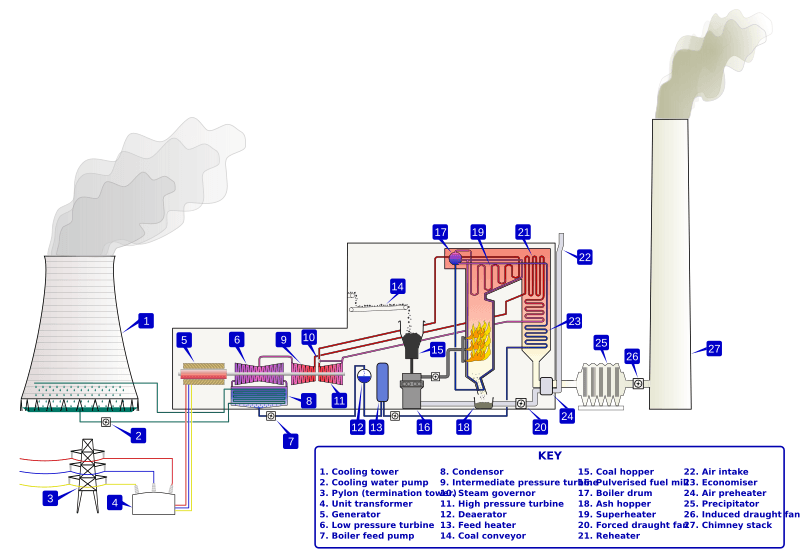Image: PowerStation3

Description: A coal-fired thermal power station. Contents 1 Key 2 References 3 Licensing 4 Original upload log Key Coal is conveyed (14) from an external stack and ground to a very fine powder by large metal spheres in the pulverised fuel mill (16). There it is mixed with preheated air (24) driven by the forced draught fan (20). The hot air-fuel mixture is forced at high pressure into the boiler where it rapidly ignites. Water of a high purity flows vertically up the tube-lined walls of the boiler, where it turns into steam, and is passed to the boiler drum (17), where steam is separated from any remaining water. The steam passes through a manifold in the roof of the drum into the pendant superheater (19) where its temperature and pressure increase rapidly to around 200 bar and 570°C, sufficient to make the tube walls glow a dull red. The steam is piped to the high pressure turbine (11), the first of a three-stage turbine process. A steam governor valve (10) allows for both manual control of the turbine and automatic set-point following. The steam is exhausted from the high pressure turbine, and reduced in both pressure and temperature, is returned to the boiler reheater (21). The reheated steam is then passed to the intermediate pressure turbine (9), and from there passed directly to the low pressure set (6). The steam, now little above its boiling point, is brought into thermal contact with cold water in the condensor (8), where it condenses rapidly back into water, creating a near vacuum inside the condensor chest. The condensed water is then passed by a feed pump (7) through a deaerator (12), and pre-warmed, first in a feed heater (13) powered by steam drawn from the high pressure set, and then in the economiser (23), before being returned to the boiler drum. The water from the condensor is sprayed inside a cooling tower (1), creating a highly visible plume, before being pumped back to the cooling water cycle. The three turbine sets are coupled on the same shaft as the electrical generator (5) which generates an intermediate level voltage (typically 20-25 kV). This is stepped up by the unit transformer (4) to a voltage more suitable for transmission (typically 250-500 kV) and is sent out onto the transmission system (3). Exhaust gas from the boiler is drawn by the induced draft fan (26) through an electrostatic precipitator (25) and is then vented through the chimney stack (27). A version of this image without the integrated key is at en::Image:PowerStation2.svg. References (1982) Modern Power Station Practice, vol 1:Planning & Layout; vol 2:Boilers, Fuel & Ash-handling plant; vol 3: Turbines & Auxiliary Equipment, Oxford: Pergamon. ISBN 0-08-016436-6. RWE npower Didcot Power Stations Drax Power Ltd How Drax works
Title: PowerStation3
Credit: Transferred from en.wikipedia to Commons.
Author: BillC at English Wikipedia
Usage Terms: Creative Commons Attribution-Share Alike 3.0
License: CC-BY-SA-3.0
License Link: http://creativecommons.org/licenses/by-sa/3.0/
Attribution Required?: Yes
Image usage
The following page links to this image:

